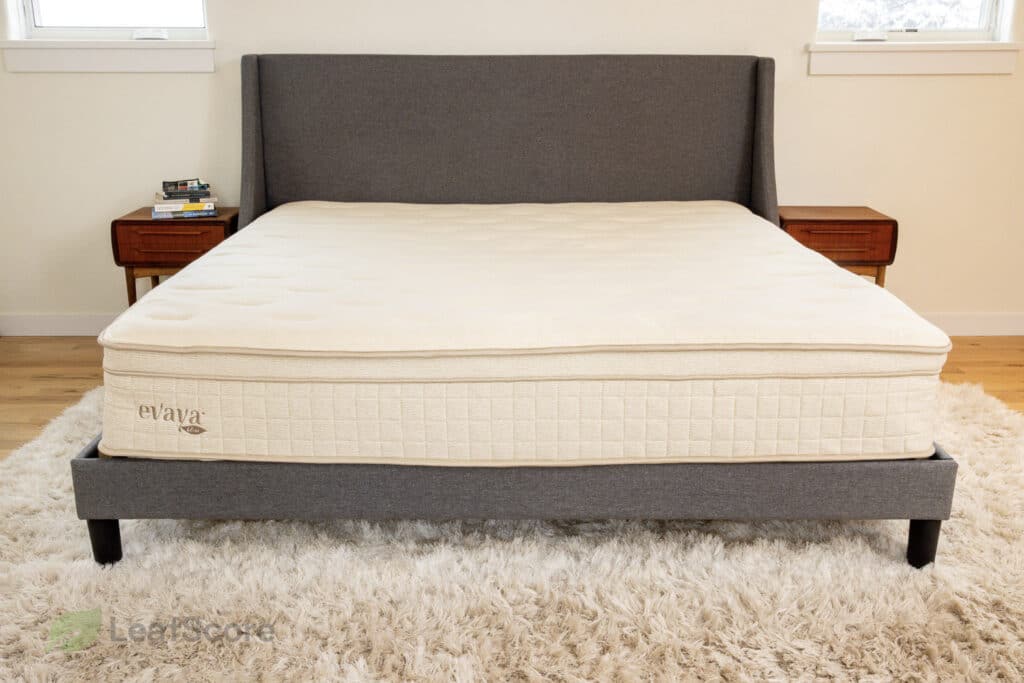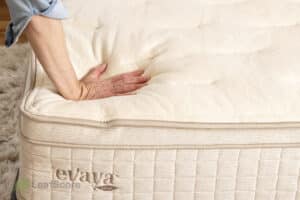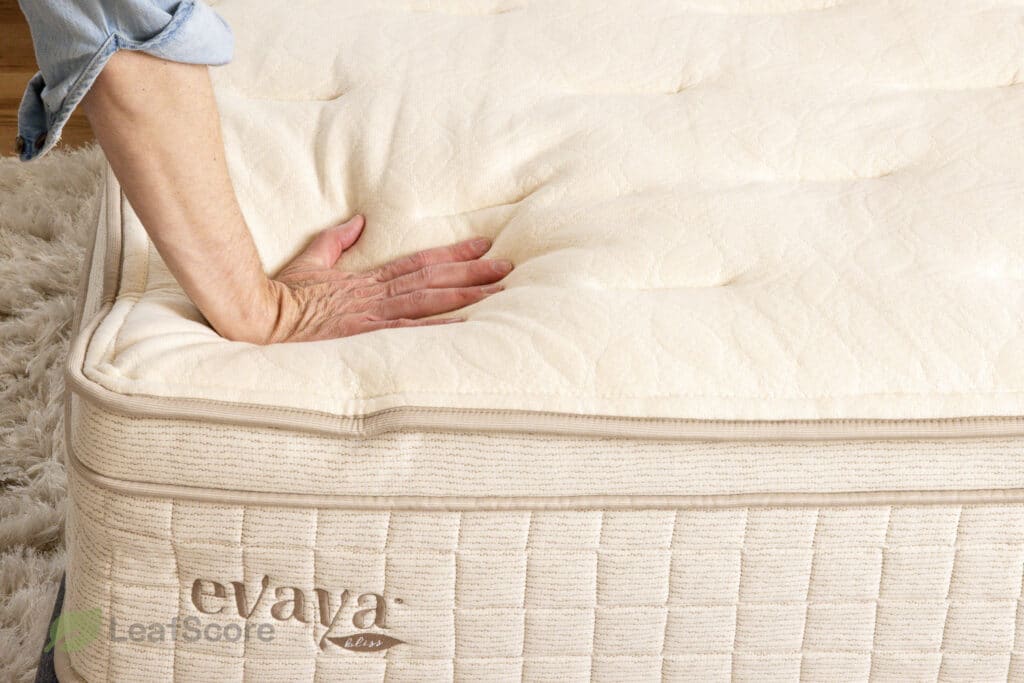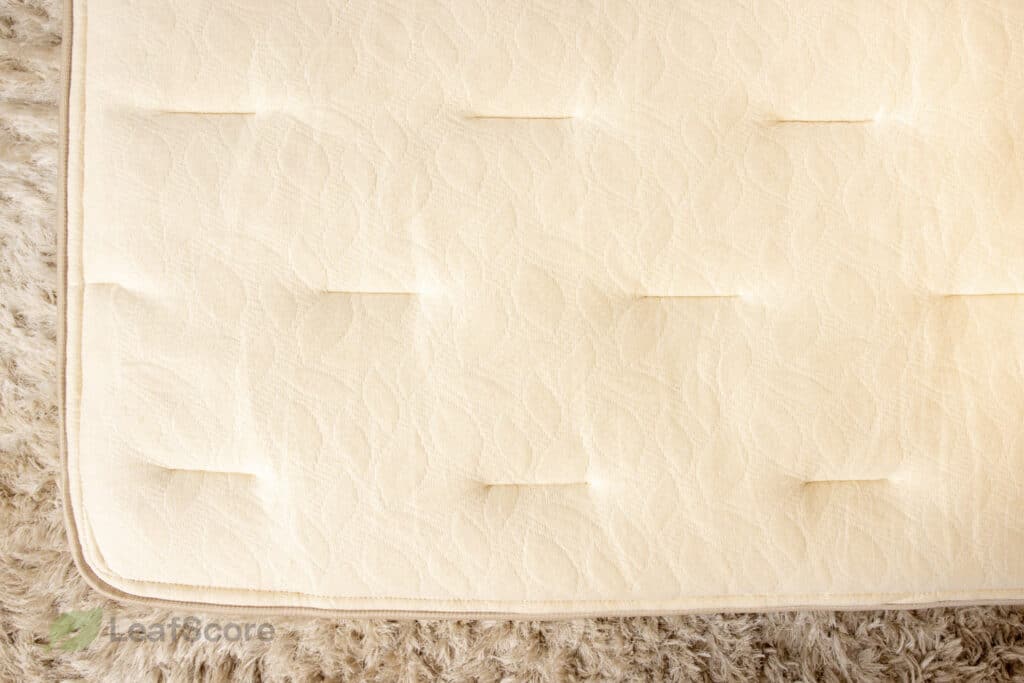Flame retardants can help keep you and your mattress safe, but not all flame retardants are non-toxic. Here’s what you need to know about mattress flame retardants.

Most mattress makers use flame retardants to reduce the flammability of mattresses and slow the spread of fire.
Several kinds of flame retardants have been used over the years, and several are now banned due to safety concerns. This is because some flame retardants are highly toxic.
Flame retardants are usually added to mattress materials rather than being part of the materials themselves. This means the chemicals aren’t bound to the fibers and can easily and continually migrate into dust, food, and water. We then breathe in, consumer, or absorb these chemicals through our skin.
Fortunately, there are good options for non-toxic, natural flame retardants that pose no risk to health.
The kind of flame retardants in your mattress will likely depend on three things:
- The age of your mattress
- The size (usually the depth) of your mattress
- What it’s made from.
The polyfoam layer is by far the most combustible part of a conventional mattress. Once fire gets through the fabric cover and into the foam it can start a rapid reaction that leads to flashover, where nearly everything in a room ignites all at once. This can be catastrophic, destroying a home very quickly and killing all its occupants.
It makes sense, then, that a mattress largely comprising what firefighters call solid gasoline, i.e., polyurethane foam, will need more powerful flame retardants than a mattress made with much less flammable natural materials.
Check out the Evaya Bliss, a Made Safe and Eco-Institut Mattress we started carrying in our online store, LeafScore Essentials. Evaya’s certifications guarantee the product is free of even trace amounts of harmful chemicals, including flame retardants. Use code ESSENTIALEVAYA for 15% off your order.
Common mattress flame retardants
Most mattress flame retardants are applied as finishes to a mattress and work by forming a protective layer on the mattress surface. This snuffs out flames or at least help prevent a mattress from burning as fast or furious.
You’ll often find the same kinds of chemical flame retardants in mattresses, couches, other upholstered furniture, electronics, and even in home insulation.
Here’s a look at some common flame retardants in mattresses.
Organohalogens and brominated flame retardants
These chemicals contain chlorine or bromine bound to carbon. They produce halogenated dioxins and furans when burned. This is thought to be a major factor in higher rates of cancer in firefighters.
These types of flame retardants are among the most widely used and are also the most problematic. Many organohalogen flame retardants (OFRs) have been banned or phased out, but those that remain haven’t undergone rigorous safety assessments and are likely to pose many of the same health risks as those already banned.
OFRs are very common in polyurethane foam products, including in children’s mattresses and toys with stuffing. So much so that Delaware brought in a ban on OFRs in 2021 for children’s products specifically.
Polybrominated Diphenyl Ethers (PBDEs)
PBDEs were once widely used in mattresses and other consumer products. Fortunately, many countries including the U.S. began phasing them out or restricting their use after it became increasingly obvious that they pose serious risks to human health and the wider environment.
The U.S. banned the use of PBDEs in 2005, so newer mattresses made in the U.S. should be PBDE-free. If you’re getting a second hand mattress or mattress topper, be sure to check its age, where it was made, and, if relevant, whether it was treated with PBDE.
PBDEs are very persistent in the environment and can accumulate in human tissues. So, even though they’re no longer permitted in manufacturing in the U.S., most of us still have PBDEs in our bodies.
PBDEs have been associated with developmental neurotoxicity and lower IQ in children, as well as endocrine disruption, among other things.
Organophosphates (OPs)
Organophosphates are compounds that contain phosphorus surrounded by oxygen atoms bound to carbon. These flame retardants are similar in structure and function to organophosphate pesticides.
These chemicals were also brought in as alternatives to PBDEs and are increasingly replacing organohalogens. As often happens, though, these chemicals present their own risks to health. Research shows they can adversely affect the reproductive, nervous, and skeletal systems.
For instance, the organophosphate chlorinated Tris (TDCPP) is now widely recognized as a carcinogen and is on California’s list of chemicals known to cause cancer.

Evaya Organic Mattress [Flame Retardant Free]
Eco-Institut and Made Safe Certified, will never off-gas, and certified to be free of even trace amounts of hazardous chemicals. Manufactured using EverEden Premium wool sourced from New Zealand farmers.
Use code ESSENTIALEVAYA for 15% off the Evaya Bliss in the LeafScore store.
Antimony trioxide
Antimony is a toxic metal (according to the EPA) and known carcinogen associated with Adam-Stokes syndrome. Unfortunately, it’s also water soluble and can become airborne as a mattress ages.
In theory, then, sleeping on a mattress treated with antimony trioxide could mean you breathe in antimony or absorb it through your skin.
PFAS (forever chemicals) aren’t used as flame retardants in mattresses. Instead, these chemicals are commonly used in firefighting foam to put out petroleum-based fires.
However, you may still find PFAS in some mattresses, just as stain repellents and waterproofing.
Melamine
Melamine is a nitrogen-rich compound sometimes used as a flame retardant in mattresses. It’s less common than other flame retardants though, given significant concerns over its potential to release harmful gasses such as ammonia when burned.
Manufacturers will also need to apply a lot more melamine than many other chemicals to meet safety requirements, which can prove expensive and less eco-friendly overall.
Boric Acid and Borate Compounds
Boric acid and borate compounds are sometimes used as flame retardants, especially by mattress makers looking for less toxic alternatives to common synthetic flame retardants.
While these chemicals are, indeed, less toxic options, they can pose a risk of exposure to high levels of boron. This element can have its own set of adverse health effects, especially on the reproductive system, kidneys, and cardiovascular system.
And, because boric acid is water soluble, sleeping on a mattress treated with this chemical could mean you absorb some through your skin.

Evaya Organic Mattress [Flame Retardant Free]
Eco-Institut and Made Safe Certified, will never off-gas, and certified to be free of even trace amounts of hazardous chemicals. Manufactured using EverEden Premium wool sourced from New Zealand farmers.
Use code ESSENTIALEVAYA for 15% off the Evaya Bliss in the LeafScore store.
Flame Resistant Materials (Modacrylic Fiber, Kevlar, and Rayon)
Instead of dousing a finished mattress with flame retardants, some mattress makers use flame resistant materials instead.
While this sounds good, the reality is that this approach often just shifts the application of flame retardants further up the supply chain.
These materials aren’t natural or naturally flame resistant. Instead, they’re treated with flame retardants during manufacturing. That means the final material is flame resistant and doesn’t need further treatment with flame retardants.
The upside of this process is that the end user is less likely to come into direct contact with any residual flame retardant chemicals. However, as these synthetic materials break down, they could release chemical flame retardants, just like more conventionally treated mattresses.
And, because the flame retardant chemicals are still being used at some point in manufacturing, there’s still an environmental impact. Unless manufacturing wastewater is properly treated, chemical flame retardants may be released into the environment to accumulate in soil, water, humans, and other animals.
Fiberglass
Fiberglass is sometimes present in mattresses as a fire retardant barrier. The trouble is that this material can easily break down and become airborne, even escaping through the top cover of a mattress.
When fiberglass starts floating around the house, it can cause skin irritation, stomach problems, and breathing problems. Fiberglass can also damage things like washing machines and dryers, clothes, bedding, towels, other furniture and flooring, electronics, and other household products.
If you move your mattress a lot, such as for cleaning, it’s definitely best to choose a mattress free of fiberglass. Check all mattress materials to avoid fiberglass exposure. If you’re not sure, contact the company. Many mattress makers aren’t upfront about using fiberglass and some are facing class action lawsuits as a result.
Flame resistant materials (without chemical treatments)
In some cases, materials like cotton are blended with polyester or acrylic and used as a flame barrier. These synthetic materials only catch fire at high temperatures, meaning they often allow a mattress to pass flammability standards without chemical flame retardants.
In addition, rayon is a synthetic material made from blending natural cellulose with silica. This combination creates a material resistant to flame, without the need for extra chemicals. So, while not 100% natural, rayon is a good alternative mattress flame barrier for anyone with chemical sensitivities who wants to avoid wool.
We’re all vulnerable to the effects of toxic flame retardants, but babies and young children are at particularly high risk. This is because they:
- Explore the world with their hands and mouths
- Spend more time on dusty floors
- Sleep more (making non-toxic crib mattresses a must)
- Breathe faster
- Have a greater lung surface area to body mass ratio
- Are still developing, meaning more opportunities for abnormal growth effects.
Natural flame retardants in mattresses
Acknowledging the deleterious effects of many flame retardant chemicals, mattress makers have begun shifting to natural flame barriers and smarter mattress construction. This way, they can still meet federal flammability standards without posing a different kind of risk to health.
One of the best ways to make a mattress less flammable is to simply skip the memory foam! A mattress made with latex, cotton, wool, and innerspring coils can very easily pass fire safety regulations without the need for any flame retardants.
Wool flame barriers
Most non-toxic mattress makers still include a wool flame barrier though. Wool is naturally resistant to fire. Indeed, it’s the most flame resistant of all natural fibers!
This is because wool has a high protein content and doesn’t catch fire easily. It also doesn’t spread flames. If it does burn, the flame is self-extinguishing, and the wool turns to ash, not embers.
Wool easily satisfies safety requirements and adds comfort, breathability, and thermoregulation. The Evaya Bliss is our top pick for a non-toxic mattress that also uses ethical, traceable wool.
Silk and cotton
Like wool, silk is also not readily ignitable and can be self-extinguishing. It would be very difficult and expensive to wrap a mattress in silk, though, and it doesn’t have the same moisture-wicking, thermoregulating properties as wool, nor is it as hardwearing.
Cotton is another flame resistant natural material. While cotton is not quite as flame resistant as wool, it’s possible to meet federal flammability requirements just with cotton. This is how many vegan mattresses are made, for instance (though some also use synthetic materials and chemical flame retardants).
Consumer safety regulations
In 2007, the U.S. Consumer Product Safety Commission (CPSC) brought out new federal guidelines for mattress flammability. The regulations require that all mattresses can withstand 30 minutes of exposure to an open flame without burning or spreading fire.
While these regulations undoubtedly help to reduce death and injury from house fires, they also shift the blame. Some cynics suspect that these regulations were a product of machinations by the tobacco industry to avoid having to create self-extinguishing cigarettes, for instance. Similarly, many house fires are caused by products such as laptops, lamps, and heating appliances that are unsafe.
The regulations also fail to require mattress makers to disclose their use of flame-retardant chemicals. That means many still use harmful chemicals, especially when they make their mattresses outside the U.S..
In 2017, the CPSR issued a warning, especially for anyone pregnant and for young children, to avoid products containing organohalogen flame retardants (OFRs), often found in mattresses, children’s toys, furniture, and electronics casings.
Still, OFRs are not banned outright in children’s products or in other consumer goods. New York and Delaware have brought in their own bans, and there are dozens of other states with their own laws prohibiting or restricting the use of certain kinds of flame retardants.
How to find a mattress without toxic flame retardants

Evaya Organic Mattress [Flame Retardant Free]
Eco-Institut and Made Safe Certified, will never off-gas, and certified to be free of even trace amounts of hazardous chemicals. Manufactured using EverEden Premium wool sourced from New Zealand farmers.
Use code ESSENTIALEVAYA for 15% off the Evaya Bliss in the LeafScore store.
One of the best ways to identify a mattress free from toxic flame retardants is to check for credible green mattress certifications. The best ones include MadeSafe™ and GOTS, because a mattress made with toxic flame retardants won’t be approved for either seal.
It’s also just good practice to look at all the materials and processes that go into making a mattress. Companies that are transparent and honest about their mattresses are usually ones that have nothing to hide. That means they usually don’t use chemical flame retardants.
If you have your heart set on a polyfoam mattress, look for one made with CertiPur foam. While this certification is a greenwashing attempt by the petroleum industry, it does at least offer some assurance that your mattress won’t contain some of the most egregious chemical flame retardants (though it’s still an environmental nightmare and health hazard in plenty of other ways).
See also: The best non-toxic mattresses

